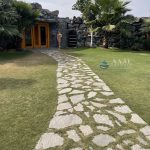Types Of Surface Textures
Stones have different surface textures, according to their formation but these days, stones are fabricated to give desired surface textures. There are six main types of surfaces that are in use.
Natural: The natural surface texture is achieved by ripping along its line of cleavage to reveal the natural grain & texture, which gives an undulating surface with great character. The surface comes with natural clefts giving a very natural look.
Honed: It is produced by grinding a surface with high grit material to a uniform specification, without producing a reflective surface. Honed stone colors are not as vibrant as polished stones. A smooth finish with a slight sheen is produced by using a polishing head. This surface is very smooth, but often very porous.
Polished: Polished surface texture is a reflection of polished crystals that bring out the brilliant colors and grains of natural stones. The shine on stone surface comes from polishing bricks and powders used during fabrication and not from any coating.
Flamed: It is a rough surface that is developed due to the bursting of crystals when the stone is heated. This surface gives an irregular textured finish.
Sand Blasted: Producing a finish similar to cleft, sand blasting involves projecting a high-pressure airline coarse-grained grit, onto the top surface of the stone. It is characterized by a textured surface with a matte gloss.
Sawn: Sawn surface is coarsely polished leaving a semi-smooth, regular finish. It is done by using a gang saw.
Bush Hammered: A pounding action that develops a textured surface. The top surface is pneumatically tooled to produce a pitted or grooved surface finish.
The Hardness Of Stones
Following is the famous measurement of hardness scale for stone, which was developed in the 1800’s. It helps in evaluating the strengths and weaknesses of the stone being used.
Measurement Of Hardness Scale
10 Diamond
9 Corundum
8 Topaz
7 Quartz (Granite)
6 Feldspar (Granite)
5 Apatite
4 Fluorite
3 Calcite (Most Marbles)
2 Gypsum
1 Talc
The idea behind the measurement of hardness scale for stone is to measure stones resistance to hardness. When sediment and grit are harder than the surface, they will scratch and harm the stone. For example, a piece of hard plastic is about a 2.0. It will not scratch #3 Calcite (Marble). However, a piece of sand that measures a 6, will scratch #3 Calcite but will not scratch #7 Quartz which is Granite. The harder the stone, the more resistant it is to abrasion. Exterior sediment that is tracked in to buildings approximately measures from 3.0 to 7.0.












